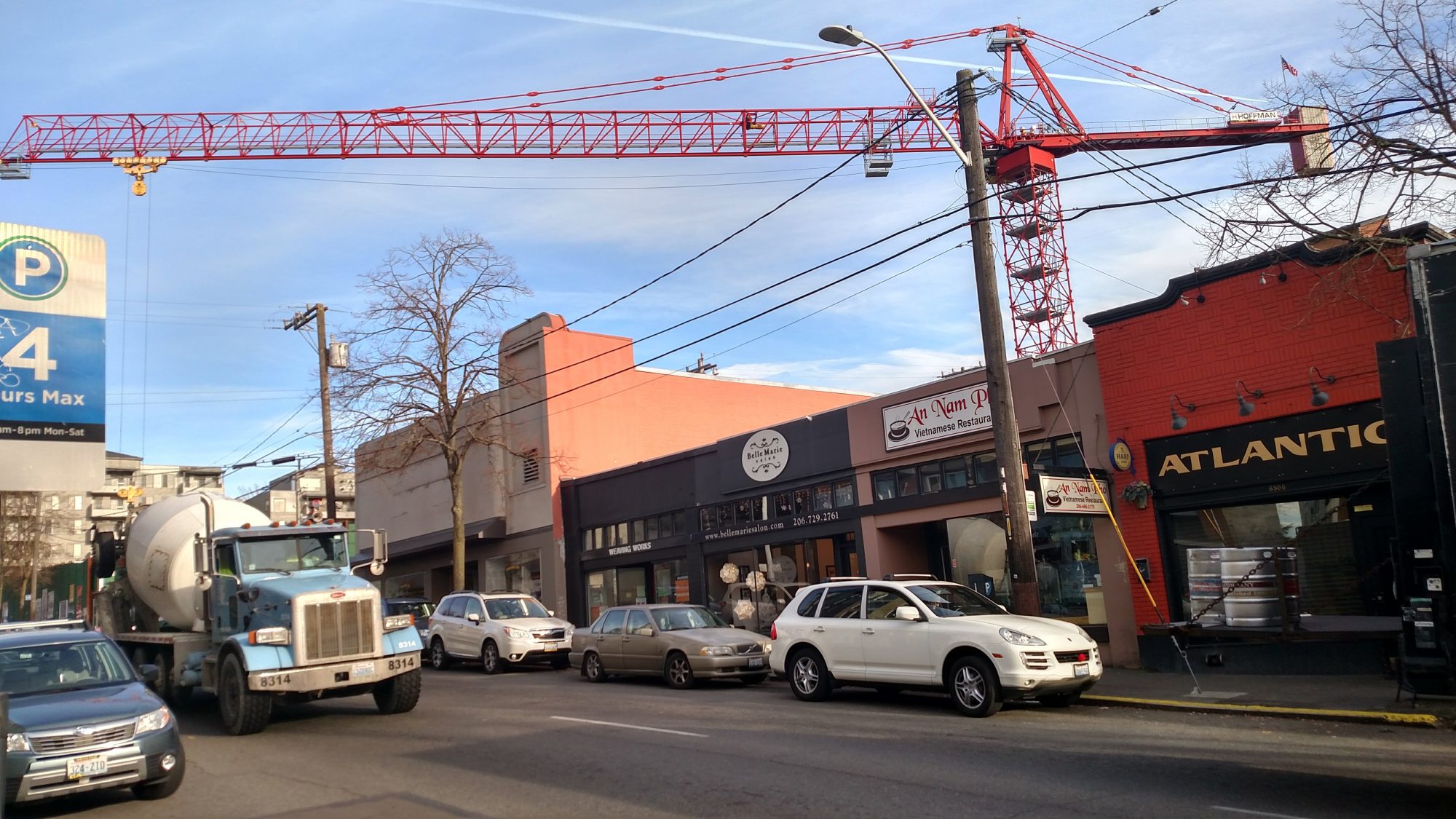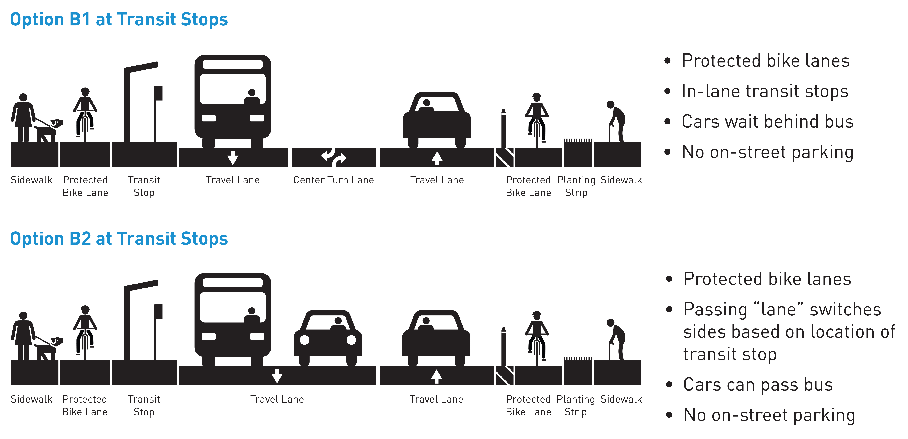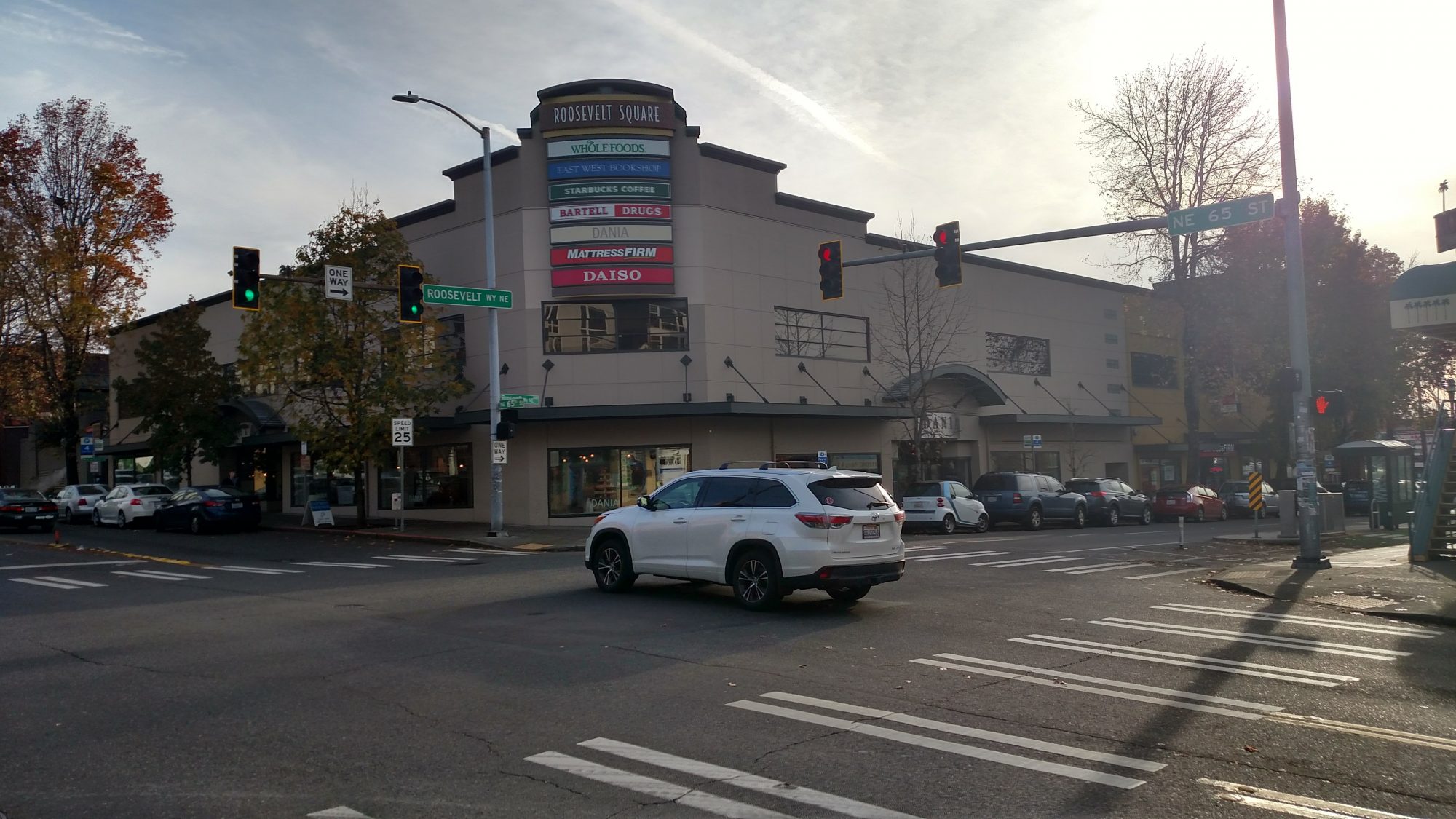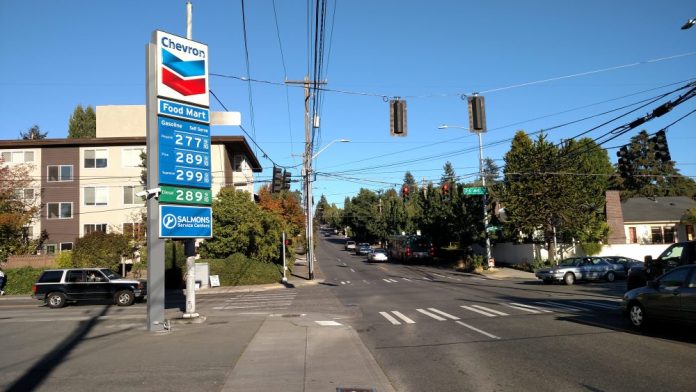Thursday morning the Seattle Department of Transportation (SDOT) hosted a drop-in session on the redesign of NE 65th St at Broadcast Coffee in Roosevelt. A few dozen people trickled through to get questions answered or give feedback. Some street safety advocates pressed SDOT to improve the design, particularly for people walking. Meanwhile, SDOT’s Community Outreach Lead Rachel McCaffrey said the design wasn’t set in stone, and some tweaks could still be possible–without committing to anything suggested at the session.
Cement trucks rumbled by on Roosevelt Way exiting the construction site opposite Broadcast Coffee, where Sound Transit is hard at work preparing Roosevelt Station for its scheduled opening in 2021. Despite light rail soon arriving in Roosevelt, SDOT so far hasn’t planned to widen sidewalks to accommodate the additional foot traffic at a station expected to get 8,000 daily riders by 2030. On the plus side, protected bike lanes between Ravenna Blvd and 20th Ave NE should improve conditions for cyclists.
“NE 65th St will soon carry tons of foot and bike traffic to a new Roosevelt @SoundTransit station. So why is @SeattleDOT planning no additional crosswalks and barely legal, far too narrow 4-foot sidewalks & bike lanes in their #Fix65th street upgrade?” said Seattle Neighborhood Greenways founder Cathy Tuttle in a tweet.
In his design analysis earlier this week, Ryan Packer noted the narrow sidewalks and lack of new crosswalks in the design. Participants at the drop-in session echoed Tuttle and Packer’s sentiments, asking for safer and more frequent pedestrian crossings, safer intersection treatments, wider sidewalks and wider bike lanes.
Reports from the first drop-in session on Tuesday left many of #Fix65th activists worried. Northeast Greenways member Andres Salomon said staff at the first session did not seem knowledgeable about the project.
“[SDOT staffers] were unable to answer various questions we had, like whether there would be turn signals added to various arterial intersections and greenway information,” Salomon said in an email. “In addition, several seemed completely unfamiliar with 65th. We’ve met numerous times to discuss problems with right-turn-on-red at 20th [Ave NE] & 65th, for example. Oralea [White] has a number of videos–we’ve emailed some of them to staff, and RBCA published this article that specifically calls out 20th & 65th. And yet, the staff member we talked to had no idea that there were any issues at 20th & 65th.”
The Case For In-Lane Bus Stops and Wider Sidewalks
To support their claim to more street space for people walking and biking, advocates can point to SDOT’s own traffic modeling, which showed that in-lane bus stops would not decrease end-to-end travel times for motorists. Notwithstanding that modeling, SDOT choose to implement in-lane stops only at Roosevelt Station and forgo them the rest of the corridor.

Option B1 (with room to pass) and Option B2 (in-lane bus stop) both showed 5.3 minutes average travel times for people in private vehicles, which is six seconds faster than existing conditions. The in-lane bus stop saves space to dedicate toward other modes, and it would also allow buses to shave more than two minutes off travel times in this one-mile segment alone, dropping average bus travel times from 8.1 minutes to 5.9. The passing lane in Option B2 slows buses down by half a minute while providing no average travel time benefits to motorists. Yet, SDOT chose that option at 60% design.

How can in-lane transit stops not slow down motorists? Motorists feel impeded waiting behind a bus at a stop. However, traffic signals and congestion chokepoints tend to dictate travel times in a corridor and speeding to the next traffic light or jam won’t necessarily save time end to end, as SDOT’s traffic model suggests.

In-lane transit stops speed up buses by avoiding the delay buses incur by needing to merge back into general traffic, which is a dangerous interaction in its own right. The National Association of City Transportation Officials (NACTO) has a whole section on in-lane bus stops, under the alias bus bulbs, expounding on the benefits to transit service. In the case of NE 65th St, choosing them wouldn’t even cost motorists time. Regardless, most authorities consider in-lane stops a best practice for frequent bus lines.
To be clear, NE 65th is a major transit corridor, with Route 62 already in the frequent service network, and it’s expected to eventually join the RapidRide network. King County Metro Transit plans to upgrade Route 62 to RapidRide standards (with even greater frequency) by 2040 according to its Metro Connects vision. A RapidRide upgrade would add off-board payment, all door boarding, sleeker buses, and improved shelters with electronic displays showing when the next bus is due.

SDOT engineer Peter Trinh was on hand fielding questions about the project; he seemed to suggest many motorists might end up not passing buses in Option B2 even provided the space to do so since it’d be a tight squeeze. With passing so iffy, Option B1 with its intentional in-lane bus stops seems all the more logical.
Building Safety Into Design
Oralea White, who is a board member with Ravenna-Bryant Community Association, shared some of the videos she’s recorded of dangerous walking conditions on NE 65th St with SDOT staff who commiserated, but also tended to frame near-misses or collisions as stemming from the poor behavior of bad drivers–not necessarily street design flaws.
https://twitter.com/OraleaW/status/925029612849053696
I asked Trinh why new crosswalks hadn’t been added in the design and he said federal regulations actually get in the way of putting in more because the agency is supposed to observe a threshold of pedestrian demand before adding a new crosswalk. Apparently, NE 65th St intersections have only surpassed that threshold at Roosevelt Way, 12th Ave NE, 15th Ave NE, 20th Ave NE, Ravenna Ave NE, and 25th Ave NE. A poorly-used crosswalk could actually endanger pedestrians if it gives pedestrians a false sense of security around still very dangerous motorists who may not heed the marked crossings, Trinh said. Not following federal regulations when adding a new crosswalk could also make SDOT liable if a injury-causing collision does happen, he explained.
I wasn’t able to confirm that interpretation of federal crosswalk regulations, and Salomon disputed it.
“This is a common misconception held among engineers,” Salomon said. “[It’s] based on an old study that showed that painting crosswalks without doing any additional traffic calming was more dangerous than not painting crosswalks, because peds had a false sense of safety.”
Advocates like the Seattle Department of Transformation have argued redesigning out streets with safety first is the best way to meet the City’s Vision Zero goal of eliminating traffic fatalities by 2030 without which we have little hope of success. The NE 65th St redesign is a step in the right direction, but overall it still leaves too many safety fixes on the table, from in-lane transit stops to curb bulbs.
“Painting crosswalks aren’t the real issue; calming traffic is,” Salomon said. “If SDOT isn’t confident that people will stop for peds in painted crosswalks, then make them raised crosswalks. Or add speed humps. Or add curb bulbs. Or do any number of things to make drivers stop for pedestrians, regardless of whether there’s a painted crosswalk or not.”
NE 65th St Plans Move Ahead with Reduced Sidewalks, Lack of Crossings
Doug Trumm is publisher of The Urbanist. An Urbanist writer since 2015, he dreams of pedestrian streets, bus lanes, and a mass-timber building spree to end our housing crisis. He graduated from the Evans School of Public Policy and Governance at the University of Washington in 2019. He lives in Seattle's Fremont neighborhood and loves to explore the city by foot and by bike.


